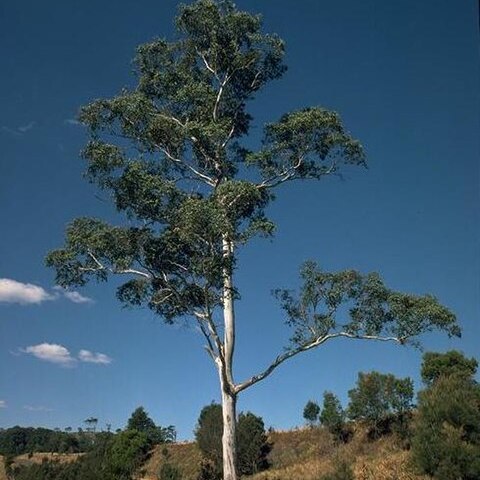Tree to 30 m tall. Forming a lignotuber. Bark smooth throughout or with some grey to grey-brown slabs of rough bark persisting on base of trunk; smooth bark sometimes slightly powdery, white, cream, pink or grey, often with ribbons of decorticated bark in the upper branches. Juvenile growth (coppice or field seedlings to 50 cm): stem rounded in cross-section, warty; juvenile leaves opposite for many pairs, sessile, ovate to broadly lanceolate, 3.5–8 cm long, 1.3–4 cm wide, base amplexicaul at first then rounded, dull, green to blue-green or slightly glaucous.Adult leaves alternate, petiole 0.5–2.5 cm long; blade lanceolate to falcate, 6–22 cm long, 1.2–2.7 cm wide, base tapering to petiole, concolorous, glossy or dull, green to grey-green, side-veins greater than 45° to midrib, moderately to densely and finely reticulate, intramarginal vein parallel to and just within margin, oil glands numerous, island.Inflorescence axillary unbranched, peduncles 0.4–1 cm long, buds 7 per umbel, pedicels 0.1–0.3 cm long. Mature buds ovoid, 0.4–0.5 cm long, 0.2–0.3 cm wide, green, scar present, operculum conical, stamens inflexed, anthers cuboid or cuneate, versatile, dorsifixed, dehiscing by longitudinal slits (non-confluent), style long, stigma blunt, locules 3 or 4, the placentae each with 4 vertical ovule rows. Flowers white.Fruit sessile or pedicellate (pedicels to 0.2 cm long), cup-shaped, obconical or hemispherical, 0.3–0.4 cm long, 0.4–0.5 cm wide, disc raised-convex, or disc level, valves 3 or 4, exserted or near rim level.Seeds black or brown, 1–2 mm long, ovoid or flattened-ovoid, lacunose, dorsal surface shallowly pitted, hilum ventral. Cultivated seedlings (measured at ca node 10): cotyledons bilobed; stems rounded in cross-section, warty; leaves sessile and opposite for at least 15 nodes, lanceolate, 3.5–8 cm long, 1.3–3 cm wide, base amplexicaul, apex rounded or pointed dull, green, new tip growth slightly waxy.
More
Juvenile leaves ovate to broadly lanceolate. Adult leaves: lamina 8–16 cm long, 1.5–3 cm wide, green or grey-green; petiole 14–22 mm long. Peduncle angular, 4–6 mm long; pedicels 1–2 mm long. Buds not glaucous; operculum conical, 1–2 mm long, 2–3 mm wide; hypanthium obconical or hemispherical, 2–3 mm long and wide. Fruits obconical to hemispherical, 4–5 mm long and wide.


